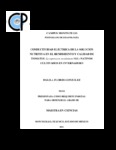| dc.description.abstract | México cuenta con una gran diversidad de tomates (Lycopersicon esculentum Mill.) nativos, sin embargo, existen pocos estudios que muestren el potencial y adaptación de estos genotipos para ser cultivados en condiciones de invernadero e hidroponía, con capacidad para competir en calidad y productividad con las variedades comerciales. Por lo anterior, los objetivos de esta investigación fueron: 1) evaluar el potencial de rendimiento de 100 genotipos nativos de tomate cultivados en invernadero e hidroponía y seleccionar los 10 genotipos más sobresalientes en rendimiento y 2) evaluar el efecto de tres valores de conductividad eléctrica (CE) de la solución nutritiva Steiner en el crecimiento, rendimiento y calidad de diez genotipos nativos sobresalientes en rendimiento. Se realizaron dos experimentos: en el primero se estableció un diseño experimental completamente al azar con cuatro repeticiones, en el que se evaluó el rendimiento en cinco racimos de 100 genotipos nativos de tomate y un híbrido (“Sun 7705”) como testigo, cultivados en invernadero e hidroponía. En el segundo experimento se utilizó un diseño factorial (3 x 12) con tres valores de CE (1, 2 y 3 dS m-1; -0.036, -0.072 y -0.108 MPa, respectivamente), diez genotipos nativos sobresalientes en rendimiento en la primera fase de la investigación (PUETHNE1-13, PUETHNE1-33, PUETHNE1-35, PUETHNE1-40, PUETHNE1-107, PUETHNE1-109, PUETHNE1-115, PUETHNE1-128, PUETHNE1-135, PUETHNE1-197) y dos híbridos comerciales (“Caiman” tipo bola y “Sun 7705” tipo saladette); se evaluaron diversas variables en planta (altura, diámetro de tallo, número de hojas, materia seca de tallo y hojas, rendimiento de cuatro racimos) y en fruto (longitud y anchura, porcentaje de jugo, pH, conductividad eléctrica en el jugo (CEJ), sólidos solubles totales (SST), acidez titulable (AT), índice de madurez (SST/AT), color (luminosidad, hue, croma), firmeza, rendimiento de pasta (RP) y concentración de licopeno). En el primer experimento, 84 genotipos nativos fueron estadísticamente similares en rendimiento al híbrido “Sun 7705”. En el segundo experimento se observó un incremento de la materia seca de tallo y hojas, SST, AT, CEJ, croma, porcentaje de jugo y RP al elevar la CE de la solución nutritiva. El híbrido “Caiman” (tipo bola) y el genotipo nativo PUETHNE1-128 exhibieron el mayor rendimiento, el resto de los genotipos nativos evaluados mostraron un rendimiento similar al híbrido “Sun 7705” (tipo saladettee). La mayoría de los genotipos nativos superaron a los híbridos comerciales en sólidos solubles totales y concentración de licopeno. Con base en el rendimiento, los genotipos nativos evaluados mostraron un alto potencial para ser cultivados en sistemas hidropónicos e invernadero; además, presentaron un gran potencial en sus características de calidad organoléptica que podrían ser utilizadas en programas de mejoramiento genético para la generación de variedades que produzcan frutos de alto valor comercial y nutracéutico. _______________ ELECTRICAL CONDUCTIVITY OF THE NUTRIENT SOLUTION ON THE YIELD AND QUALITY OF NATIVE TOMATOES (Lycopersicon esculentum Mill.) GROWN IN GREENHOUSE. ABSTRACT: Mexico has a great diversity of native population of tomato (Lycopersicon esculentum Mill.), however, there are few studies about the potential and adaptation of these genotypes to be cultivated in greenhouse and hydroponics, and to compete in quality and productivity with commercial varieties. Therefore, the objectives of this research were: 1) to evaluate the potential yield of 100 native genotypes of tomato grown in greenhouse and hydroponics and select the 10 outstanding genotypes in yield and, 2) to assess the effect of three electrical conductivity (EC) of the Steiner nutrient solution on growth, yield, and quality of ten outstanding native genotypes in yield. Two experiments were conducted. In the first an experimental design was established completely at random with four replications, yield was evaluated in five clusters of 100 native genotypes of tomato and a hybrid ("Sun 7705") as a control, cultivated in greenhouse and hydroponics. In a second experiment a factorial design (3 x 12) was established; with three EC levels (1, 2 and 3 dS m-1; - 0.036, - 0.072 and - 0.108 MPa, respectively), and ten outstanding native genotypes in yield selected from the first experiment (PUETHNE1-13, PUETHNE1-33, PUETHNE1-35, PUETHNE1-40, PUETHNE1-107, PUETHNE1-109, PUETHNE1-115, PUETHNE1-128, PUETHNE1-135, PUETHNE1-197) and two commercial hybrid tomatoes ("Caiman" ball type and "Sun 7705" saladette type). Variables evaluated in the second experiment were: height, stem diameter, number of leaves, dry matter of stem and leaves, yield from four clusters, and in fruit were length and width, percentage of juice, pH, electrical conductivity in juice (ECJ), total soluble solids (TSS), titratable acidity (TA), maturity index (TSS/TA), color (brightness, hue and chroma), fruit firmness, yield of paste (YP) and lycopene concentration. In the first experiment, 84 native genotypes were statistically similar in yield to the hybrid "Sun 7705". In the second experiment it was observed an increase in dry matter of stem and leaves, TSS, TA, ECJ, chroma, percentage of juice and RP to raise the EC of the nutrient solution. The hybrid "Caiman" (ball type) and the native genotype PUETHNE1-128 exhibited the highest yield, the rest of the tested native genotypes showed a similar production to the hybrid "Sun 7705". Most of the native genotypes surpassed the commercial hybrids in total soluble solids and lycopene concentration. Based on yield, native genotypes assessed showed a high potential to be grown in hydroponics and greenhouse. In addition, these showed great potential in characteristics of organoleptic quality that could be used in breeding programs for the generation of varieties to produce fruits of high commercial value and nutraceutical quality. | es |


